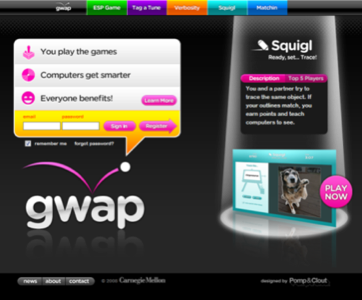Last week a new site called Gwap was launched by Carnegie Mellon’s School of Computer Science. The site offers an array of multi-player games that have a benefit beyond just that of momentary distraction or amusement. These games are helping improve image and audio searches, teaching computers to see, and enhancing AI. However, all that won’t matter to the players because, as it turns out, these games are actually fun.

About Gwap
Nicholas Carr blogged about Gwap a couple of days after its launch, noting that “one thing the Internet enables, which wasn’t possible before, at least not on anywhere near the same scale, is the transfer of human intelligence into machine intelligence.” In Gwap, which stands for “Games With a Purpose,” that transfer of intelligence is done by getting people to do the routine chores that computers don’t know how to do – chores like tagging photos, describing songs, and outlining objects, as well as transferring a good bit of human common sense to the machine. The trick to getting people to do these things is to make the work fun. Hence the games.
The creator of these games is Luis von Ahn, winner of a 2006 MacArthur Foundation “genius grant” and a pioneer in the field of human computation. Ahn is most notable for helping to develop CAPTCHAs (Completely Automated Public Turing Test to Tell Computers and Humans Apart), those somewhat annoying but rather effective distorted letter puzzles used millions of times each day. Last year, he also introduced the “reCAPTCHA,” where CAPTCHAs were used to gain access to a web site while also helping digitize old books.
Gwap homepage

The Games
Gwap currently features five games, one of which is an old classic called the ESP Game. In the ESP game, two players view the same image and try to guess words that the other player would use to describe it. Google licensed this technology and launched Google Image Labeler to help improve the quality of their image search results.
The four new games include:
Matchin, a game in which players judge which of two images is more appealing, is designed to eventually enable image searches to rank images based on which ones look the best.
Tag a Tune, in which players describe songs so that computers can search for music other than by title – such as happy songs or love songs.
Verbosity, a test of common sense knowledge that will amass facts for use by artificial intelligence programs.
Squigl, a game in which players trace the outlines of objects in photographs to help teach computers to more readily recognize objects.
According to the Carnegie Mellon announcement, von Ahn plans to add a lot of games to the site, saying “we have three more that we’ll be launching in the coming months.” He hopes that by having all the games on the same site it will encourage players to try several different ones. Players also have a single sign-on and password, Top Player rankings, and online chats, said von Ahn.
The Human Processor
In his whitepaper entitled “Invisible Computing,” von Ahn compared game design to to algorithm creation, saying:
“…it must be proven correct, its efficiency can be analyzed, a more efficient version can supersede a less efficient one, and so on. Instead of using a silicon processor, these “algorithms” run on a processor consisting of ordinary humans interacting with computers over the Internet.”
In other words, we’re the processor. The machine is us.
This concept isn’t entirely new – Amazon’s Mechanical Turk, for example, pays people to contribute their time to work on small, simple tasks called “Human Intelligence Tasks,” or HITs. However, unlike HITs, which can sometimes be boring or tedious, the games on Gawp are actually fun – and they don’t feel like work.
Some believe that human powered processing is the next big wave for computing. You could argue that Mahalo, the human-powered search engine is an example of this. (Though others call it a human-powered link farm.) Perhaps a better example is ChaCha, the mobile Q&A service that uses human guides to respond to questions called or texted in from your cell phone. We’ve also covered other human-powered services on RWW in the past, like the Galaxy Zoo and Stardust@Home project, among other (our coverage here). Many of these efforts have tried to incorporate an element of “fun” into what is actually work.
Whether Gwap will actually gain momentum and get a large number of people involved is yet to be seen, but it is definitely has potential to help teach computers the things they can’t do for themselves….yet.










